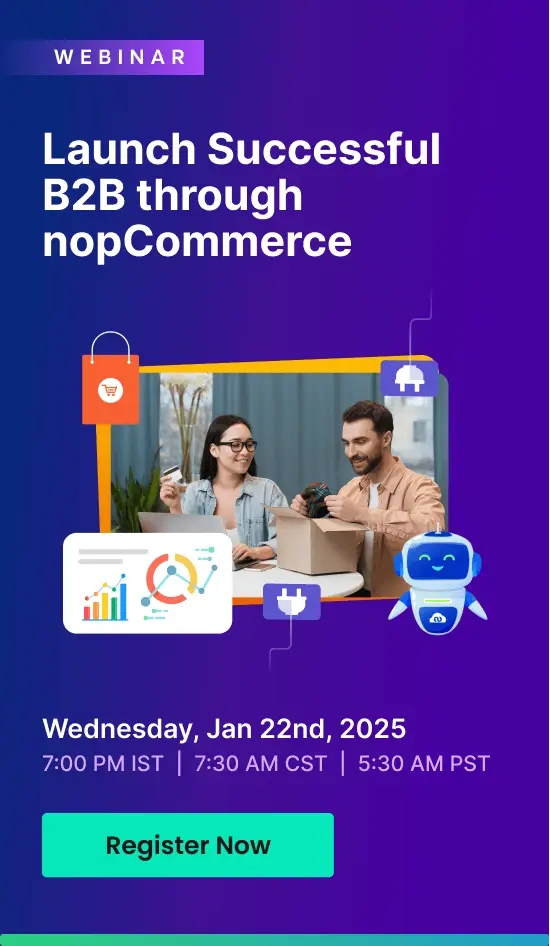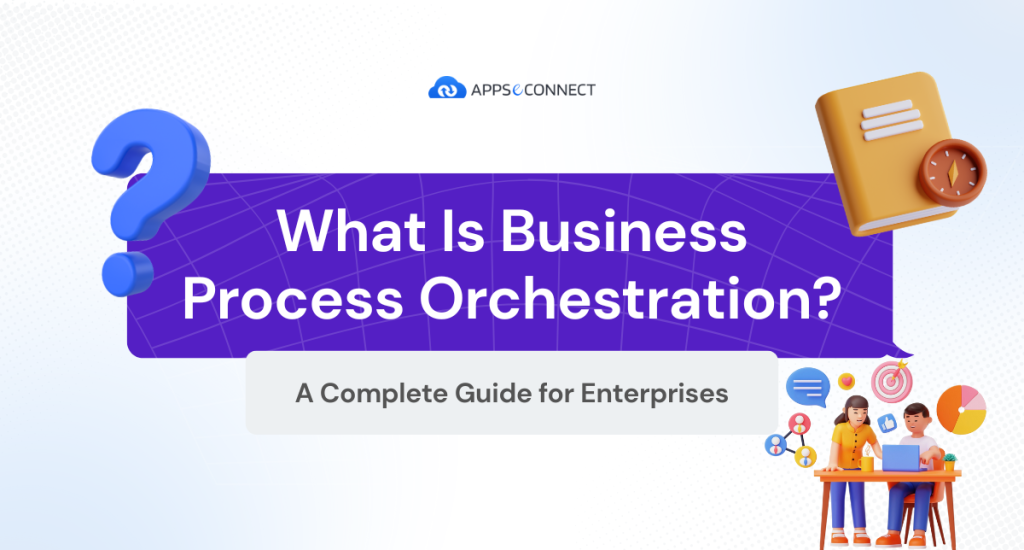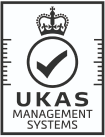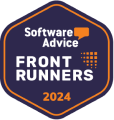Modern enterprises face a critical challenge: their business processes span multiple departments, systems, and technologies that often operate in isolation from one another. This disconnection creates several problems:
- Marketing campaigns fail to sync with inventory levels
- Sales orders get lost between CRM and ERP systems
- Customer service teams lack real-time access to order fulfillment data
- Manual handoffs cause delays and errors
- Data silos prevent accurate decision-making
While many organizations have automated individual tasks, they struggle to coordinate these automated processes into a cohesive workflow. This is where business process orchestration becomes essential.
Business process orchestration addresses an important question: how do you ensure that all your systems, teams, and processes work together seamlessly?
Read more to get the full picture.
What Is Business Process Orchestration (BPO)?
Business process orchestration connects all your business systems and makes them work together automatically. It ensures that when something happens in one system, all your other systems respond correctly without anyone manually moving data between them.
For example, a customer places an order on your website. Without orchestration, someone must manually enter that order into your inventory system, then notify the warehouse, then update accounting, then inform customer service. Each step requires human effort and creates opportunities for delays and errors.
With orchestration, the customer’s order automatically triggers a chain reaction across all your systems.
- Your inventory system immediately reserves the products.
- Your warehouse system receives fulfillment instructions.
- Your accounting system creates an invoice.
- Your CRM updates the customer record.
- Your shipping system generates tracking information.
All this happens in seconds without anyone touching the data.
Core Components of Business Process Orchestration
- Intelligent Workflow Management: Defining and managing complex workflows that span multiple systems, departments, and decision points. These workflows can adapt based on business rules, conditions, and real-time data.
- System Integration: Connecting disparate applications like ERP, CRM, e-commerce platforms, inventory management systems, and payment gateways so they communicate seamlessly without manual intervention.
- Data Synchronization: Ensuring that data flows accurately and consistently across all connected systems, maintaining a single source of truth throughout your organization.
- Process Visibility: Providing real-time monitoring and analytics so you can see exactly where processes stand, identify bottlenecks, and make data-driven improvements.
- Exception Handling: Automatically managing errors, delays, or unexpected conditions by triggering alternative workflows or alerting the right people to intervene.
For enterprises, business process orchestration becomes the central nervous system that connects everything. From the moment a customer places an order online through fulfillment, invoicing, shipping, and customer service follow-up, orchestration ensures that when something happens in one system, all dependent systems respond appropriately without human intervention.
Business Process Orchestration vs. Automation
Many organizations confuse business process orchestration with automation, but they serve fundamentally different purposes. Understanding this distinction will help you choose the right solution to your operational challenges.
Business Process Automation focuses on replacing manual, repetitive tasks with automated ones. It’s about making individual activities faster and reducing human error. For example:
- Automatically generating invoices from sales orders
- Sending triggered email responses to customer inquiries
- Auto-populating forms with customer data
- Scheduling social media posts
Automation is typically linear and task-specific. It answers the question: “How can I make this one task happen without manual work?“
Business Process Orchestration operates at a higher level. It coordinates multiple automated processes, systems, and human tasks to achieve complex business outcomes. It’s about the bigger picture, where you make sure all your automated processes work together intelligently. For example:
- Managing the entire order-to-cash cycle across ERP, CRM, inventory, warehouse, shipping, and accounting systems
- Coordinating customer onboarding across sales, legal, IT, and billing departments
- Synchronizing product launches across supply chain, marketing, sales, and e-commerce platforms
Orchestration is dynamic and context-aware. It answers the question: “How do all these processes need to work together to achieve my business goal?“
| Aspect | Automation | Orchestration |
|---|---|---|
| Scope | Single task or process | End-to-end workflows across systems |
| Complexity | Simple, linear workflows | Complex, multi-system processes |
| Intelligence | Rule-based execution | Context-aware coordination |
| Integration | Limited or isolated | Deep, multi-directional integration |
| Adaptability | Fixed workflows | Dynamic, conditional workflows |
| Value | Efficiency in specific tasks | Strategic business outcomes |
Let’s take a practical example: You might automate invoice generation (automation), but orchestration ensures that when the system generates an invoice, the accounting system gets updated, the inventory is adjusted, the shipping system gets notified, the sales team receives commission updates, and the customer receives tracking information. This is all coordinated in the right sequence with proper dependencies.
Orchestration eliminates the gaps between automated silos where work still gets stuck, delayed, or lost.
Why Enterprises Need Business Process Orchestration
Enterprise organizations operate in unprecedented complexity. The average organization uses over 1000 applications across its departments. Each system serves a purpose, but together they create a fragmented technology ecosystem where critical business processes break down in the gaps between systems. And it leads to critical challenges:
Disconnected Systems Create Operational Chaos
76% of customers expect seamless interactions across departments, yet 54% say sales, service, and marketing don’t share information. Your sales, operations, finance, and support teams often work in disconnected systems. When sales close a deal in Salesforce, the data doesn’t flow automatically to ERP, warehouse, or accounting. It forces manual updates that cause delays and errors.
Data Silos Lead to Poor Decisions
Poor quality data leads to an average $12.9 million in losses each year. When customer data lives in your CRM, order history sits in your ERP, and support tickets reside in your helpdesk system,teams make decisions based on incomplete information.
WaterTech Corp. faced similar challenges before integrating SAP Business One with its e-commerce and logistics systems. The lack of unified data caused inventory errors and delayed fulfillment, but integration delivered real-time visibility and faster, more informed decision-making.
Manual Handoffs Slow Everything Down
Employees spend hours moving data from one system to another. They export files, reformat information in spreadsheets, and import data into different applications. This manual work slows down every process and introduces errors that create bigger problems downstream.
Scaling Becomes Nearly Impossible
As your business grows, the complexity multiplies exponentially. What worked when you had 50 employees and three systems becomes unmanageable with 500 employees and 30 systems. Without orchestration, scaling means hiring more people to handle the increased manual work between systems.
For instance, APPSeCONNECT helped its client, Josie Maran Cosmetics, efficiently manage thousands of orders per week. It provided a robust, low-code integration between its ERP (SAP B1) and ecommerce (Shopify) to automate order management at scale and eliminate the need for manual handling.
Customer Expectations Have Changed
Customers expect instant order confirmation, real-time tracking, proactive communication, and seamless experiences across all channels. They compare you to top competitors regardless of your industry. Delivering this experience requires perfect coordination across all backend systems, which manual processes cannot achieve.
Key Benefits of Business Process Orchestration
Business process orchestration delivers measurable improvements across your entire operation. Here’s what organizations achieve when they implement orchestration effectively.
Better Operational Efficiency
Orchestration eliminates the manual work of moving data between systems. Processes that took days are now complete in hours. Your team stops wasting time on data entry and focuses on work that drives business growth.
A process orchestration software like APPSeCONNECT accelerates this efficiency by providing pre-built connectors for 200+ business applications. You connect your ERP, CRM, e-commerce platform, and other systems without custom coding, getting your orchestration running in weeks instead of months.
Perfect Data Accuracy
Automated data flow eliminates errors from manual entry. When information updates in one system, it instantly syncs across all connected systems. Everyone sees the same accurate data in real-time. Sales, operations, finance, and customer service all work from a single source of truth.
Faster Customer Response
Orchestration speeds up every customer-facing process. You can reduce the order-to-cash cycles that may take weeks to days. Customer onboarding that required a month finishes in under two weeks. You respond to market changes and customer needs faster than competitors, still relying on manual processes.
Better Customer Experiences
When systems communicate automatically, customers get the seamless experiences they expect. They receive instant order confirmations, real-time tracking updates, and consistent information across all channels. Your team answers customer questions immediately because they have complete, current information at their fingertips.
Effortless Scaling
Orchestrated processes handle increased volume without requiring more staff. Whether you process 100 orders daily or 10,000, the workflows scale automatically.
Wilderness Trail Bikes (WTB) experienced this firsthand when they integrated Shopify Plus with SAP Business One using APPSeCONNECT. During peak Black Friday sales, they successfully synced 99% of their bulk orders without adding resources. This level of automation lets businesses grow without proportionally increasing operational costs, transforming their ability to enter new markets and launch new products profitably.
Real-World Use Cases of Business Process Orchestration
Understanding how orchestration works in practice helps clarify its value. Have a look at common enterprise scenarios where orchestration delivers significant impact:
Order-to-Cash Process
This critical workflow spans multiple systems and departments. When a customer places an order on your e-commerce platform, orchestration ensures:
- The order automatically flows to your ERP system
- Inventory levels update across all channels immediately
- The warehouse management system receives fulfillment instructions
- The shipping system generates labels and tracking information
- The accounting system creates invoices
- The CRM updates with the order history
- The customer receives automated updates at each stage
- Sales commissions are calculated automatically
Without orchestration, this process requires manual handoffs at each stage, creating delays, errors, and frustrated customers. With orchestration (enabled by platforms like APPSeCONNECT), the entire process flows seamlessly from order placement to payment collection without human intervention.
Multi-Channel Inventory Management
Retail and distribution enterprises selling across multiple channels face inventory synchronization challenges. Orchestration ensures that when inventory levels change in your warehouse:
- All sales channels (website, Amazon, eBay, retail stores) update instantly
- Purchasing systems trigger reorder workflows when stock reaches thresholds
- Sales teams see accurate availability for customer commitments
- Marketing adjusts campaigns based on inventory availability
- Finance receives updated inventory valuations
This prevents overselling, reduces stockouts, and optimizes inventory investment across channels.
Take the example of DIGI TECH Trading, a Dubai-based retailer of filmmaking equipment. They faced frequent out-of-stock errors on their Magento store despite having stock available in SAP Business One. By integrating both systems through APPSeCONNECT, DIGI TECH achieved real-time, bi-directional synchronization that eliminated inventory mismatches and improved customer experience.
Customer Onboarding
For B2B enterprises, customer onboarding involves multiple departments and systems. Orchestration coordinates:
- Sales completing the deal in CRM
- Legal generating and tracking contract signatures
- Finance is setting up billing and payment terms
- IT provisioning system access and credentials
- Customer success creating onboarding projects
- Operations configuring customer-specific workflows
Instead of this process taking weeks with constant follow-up and manual tracking, orchestration reduces onboarding time by 50-70% while ensuring nothing falls through the cracks.
Supply Chain Coordination
Manufacturing and distribution enterprises orchestrate complex supply chain workflows:
- Purchase orders triggering supplier notifications
- Inbound shipment data flowing to warehouse systems
- Quality control results updating inventory status
- Production schedules are adjusting based on material availability
- Customer delivery commitments are updated based on supply chain changes
This coordination prevents costly production delays, reduces inventory carrying costs, and improves customer delivery reliability.
Financial Close Processes
Month-end and quarter-end financial closes traditionally consume days of manual effort. Orchestration automates:
- Data collection from multiple operational systems
- Reconciliation workflows across GL accounts
- Approval routing for journal entries
- Report generation and distribution
- Compliance checklist execution
Organizations reduce close cycles from 10+ days to 3-4 days while improving accuracy and audit compliance.
Best Practices for Implementing Business Process Orchestration
You need successful strategic planning and disciplined execution to implement business process orchestration. Here are proven BPO implementation best practices for enterprises:
- Start with High-Impact Processes: Don’t try orchestrating everything at once. Focus on processes that are critical to revenue or customer satisfaction, currently causing significant pain through errors and delays, spanning multiple systems and departments, and consuming excessive manual effort.
- Map Your Current State First: Document how processes actually work today, not how you think they should work. Interview people who perform the work daily and observe processes in action. Identify all systems, handoffs, and workarounds currently in use.
- Define Clear Success Metrics: Establish baselines and targets for process cycle time, error rates, manual effort hours, customer satisfaction scores, and cost per transaction. These metrics prove ROI and guide continuous improvement.
- Choose the Right Platform: Select an orchestration platform with pre-built connectors for your critical systems, visual workflow design tools, flexibility for complex business rules, real-time monitoring capabilities, and strong security features.
APPSeCONNECT provides 200+ pre-built connectors and intuitive workflow design, enabling enterprises to implement orchestration quickly without extensive custom development. - Involve Business Users Early: Include business process owners throughout design and implementation, not just IT teams. They understand the nuances, exceptions, and business context that determine whether orchestration solves real problems.
- Design for Real-World Conditions: Build exception handling into your design from the start. Account for system outages, data validation failures, missing information, and business rule exceptions. Perfect processes don’t exist, so plan for problems before they occur.
- Monitor Everything: Implement dashboards showing process status, bottlenecks, error rates, system performance, and transaction volumes. You can’t improve what you can’t measure. Real-time visibility enables proactive problem resolution.
- Manage Organizational Change: Invest in clear communication about benefits, training for affected users, documentation of new workflows, and support during transition periods. Technology alone doesn’t ensure success without proper change management.
- Start Small, Scale Fast: Implement a pilot with one process or business unit. Learn what works, refine your approach, then rapidly expand. This reduces risk while accelerating time-to-value and building organizational confidence through demonstrated success.
APPSeCONNECT: Your #1 choice for Business Process Orchestration
95% of enterprises leveraging APPSeCONNECT achieve full ROI within just six months.
APPSeCONNECT deeply understands business requirements, providing a seamless integration between ecommerce and ERP. It enables bidirectional data exchange across systems, eliminating manual data entry and ensuring complete synchronization.
With its distinctive iPaaS approach and advanced capabilities, APPSeCONNECT stands out from competitors like Workato, Jitterbit, Celigo, and SnapLogic.
Here’s a look at a detailed comparison between the top iPaaS vendors:
| Feature Category | APPSeCONNECT | Workato | Jitterbit | Celigo | SnapLogic |
|---|---|---|---|---|---|
| Pricing & TCO (Total Cost of Ownership) | ★★★★★ Lowest TCO with flexible pricing |
★★★★☆ High-cost enterprise pricing |
★★★☆☆ Mid-range with add-on costs |
★★★☆☆ Tiered pricing, can become costly |
★★☆☆☆ Premium pricing, high volume costs |
| Implementation Time | ★★★★★ Rapid Deployment (2-3 weeks typical) |
★★★☆☆ 1-3 months typical timeline |
★★★☆☆ 1-2 months with expert help |
★★★★☆ Fast for NetSuite, slower for other |
★★☆☆☆ 3+ months complex setup |
| Pre-built Connectors | ★★★★★ 300+ with business process templates |
★★★★☆ 400+ but less industry-specific |
★★★☆☆ 200+ connectors basic templates |
★★★☆☆ Strong NetSuite limited elsewhere |
★★★★☆ 500+ connectors lack depth |
| Ease of Use | ★★★★★ Intuitive interface, no coding required |
★★★★☆ Good UI but steeper learning |
★★★☆☆ Developer-oriented, less intuitive |
★★★★☆ Simple for basics, complex for custom |
★★★☆☆ Pipeline UI, technical learning |
| Technical Support | ★★★★★ Direct developer access, 24/7 |
★★★☆☆ Tiered support, premium costs |
★★★☆☆ Good but slow response |
★★★★☆ Responsive for paid accounts |
★★★☆☆ Limited to business hours |
| Scalability | ★★★★★ High throughput, auto-scaling |
★★★★☆ Good enterprise scalability |
★★★☆☆ Handles high transaction volume |
★★★☆☆ Mid-level performance |
★★★★☆ Large-scale data handling |
| Industry-Specific Features | ★★★★★ Deep Vertical specialization |
★★★☆☆ Generic workflows, less specialized |
★★★☆☆ Limited industry specialization |
★★★★☆ Strong NetSuite focus only |
★★★☆☆ Generic approach, not specialized |
You can now easily spot differences between its competitors. APPSeCONNECT’s main differentiators are its ease of use, implementation time, customer support, and integration flexibility.
So, if you’re looking for a well-rounded integration platform that will serve all your Integration needs within a budget, the best option is APPSeCONNECT.
The ultimate tool for all your integration needs!
Final Thoughts
Your team works hard, but manual processes hold everyone back. You see the problem clearly, but solving it feels overwhelming.
Business process orchestration gives you a way forward. You don’t need to fix everything overnight. Start with the one process causing you the most pain right now. Connect those systems, automate that workflow, and give your team relief from repetitive manual work.
Within weeks, you’ll see faster processing, fewer errors, and happier customers. More importantly, your employees can finally focus on meaningful work.
APPSeCONNECT understands enterprise challenges because we’ve helped hundreds of organizations through this journey. Our 200+ pre-built connectors and simple design tools mean you can start orchestrating without a massive IT project or months of implementation.
Your team deserves better tools. Your customers deserve better experiences. You deserve to see your business run smoothly.
Frequently Asked Questions
Orchestration eliminates manual work between systems, reduces operational costs, and speeds up processes. This allows you to scale revenue without proportionally increasing headcount or expenses.
Orchestration enables real-time order tracking, instant confirmations, accurate information across all channels, and proactive communication. Customers get the seamless, fast experiences they expect from modern businesses.
Orchestration creates a single source of truth across systems, eliminates data silos, automates workflows, and provides real-time visibility. This enables faster decisions and consistent execution across your organization.
Orchestration quickly connects systems from acquired companies to your existing infrastructure. This speeds up integration timelines, maintains business continuity, and helps you realize M&A value faster without lengthy IT projects.
Yes. Orchestration consolidates data from all systems in real-time, providing complete visibility for analytics. You can track performance, identify trends, and make informed decisions based on accurate, current information.
Start by involving business users in orchestration design, celebrate automation wins, provide training on new workflows, and demonstrate how orchestration makes everyone’s work easier and more meaningful.
Choose platforms with pre-built connectors for your systems, visual workflow design, real-time monitoring, scalability for growth, and strong security. APPSeCONNECT provides all these capabilities in one enterprise-grade platform.

























